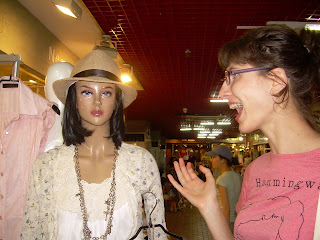
On Sunday, our co-worker, Hong, took Kristin and I to one of "Korea's best kept secrets": Heryi Art Village. Heryi is like another world inside of Korea. It's quite close to the border of North and South. The weather was overcast the whole day, making the surroundings dream-like. There weren't many people abound, which meant plenty of gazing space.

Heryi is something of an artists' commune or complex. We wandered about in the maze of buildings that had a war-time look, and found art pieces of all sorts: some strange, complex, others simple and familar looking. There were a lot of juxtaposed pieces: bodies and paintings of trees, a sculpture of a head made of watches, a painting of strange looking women with seashells for eyes.

The village was amongst the most lush of grasses, fish ponds, wild flowers : strange to be in a place that consisted of concrete buildings, art, and nature (so many juxtapositions-- other than that of the art).

Inside of one of the galleries grew this massive cactus garden, which became the focus of a good bit of my photographic shots for the day. I thought of my mum enjoying the garden of pricklies. The most amazing was the center cactus, it must have been a good twenty-five feet tall, though perhaps I'm underestimating.

My favorite of pieces was a sculpture of a boy perched on the window sill with three little birdies. He had such a nice day-dreamy look to him, I so wanted to join him. I would have broken the pole though as a good part of the day was spent dining on absurdly delicious Italian food at the eateries. Heryi was full of cultural entertainment. To end the day we went to the concert hall/ coffee and tea room and became day-dreamed (much like the boy though perched on chairs) while sipping fresh tea. Hong is a tea expert and ordered us all of mild cup of tea, which had a name that started with a P., I cannot recall, but I do recall that it was a form of green tea, and made me feel plenty relaxed with Shubert and thoughts of the day.
The internet has a few links for more information on the history and the art village itself:
http://www.heyri.net/contents/english/e_profile.asp (you have to click the English link each time you go to a new page on this site), and
http://world.kbs.co.kr/english/culturenlife/culturenlife_discover_detail.htm?no=903; and
http://aru.londonmet.ac.uk/works/heyri/ (this one shows the oddity of the buildings).


























